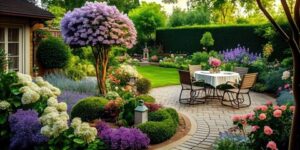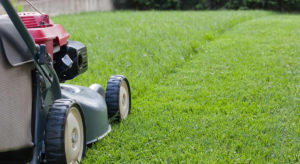A beautiful landscape makes your home feel like a personal retreat. There is something about the sunshine, green grass, beautiful flowers, tantalizing scents and frolicking animals that just make people happy.

Before beginning a landscaping project, it is important to do a thorough site assessment. This will help determine existing conditions and any positive or negative elements that should be considered when making design decisions. Visit https://www.ecograssnwa.com/ for more details.
One of the most important components in landscape design is color. Not only does it add a dramatic flair to a garden, but it can also unify a space and draw attention to specific focal points. Whether you’re a newbie to the world of gardening or a seasoned enthusiast, understanding the basics of color theory can help you take your outdoor aesthetic to the next level.
A basic principle of color design is unity, which refers to the idea that all elements within a landscape should work together to create a harmonious whole. This can be achieved by using plants with similar characteristics as the foundation for your design (plants that have the same size, color and type of leaf, flowers with similar appearance, etc.).
Alternatively, you can use contrast to highlight certain elements of your garden, such as trees, buildings or even individual plants. Choosing contrasting colors to highlight these features will make them stand out against the background of your landscape, adding visual interest and making them easier to identify.
Another consideration when selecting colors for your landscape is that different hues are associated with various feelings and emotions. For example, bold and vibrant colors like reds, yellows, and greens are said to stimulate the senses and energize a person. Meanwhile, cooler colors such as blues and pastel shades are often thought to evoke a sense of calmness and tranquility.
When deciding on your landscape colors, it’s also helpful to consider the surrounding architecture and environmental factors such as soil conditions and nearby vegetation. This can help you and your landscape designer choose colors that complement rather than clash with these existing elements of your property.
It’s also a good idea to have at least one dominant color that will act as the anchor of your landscape design. This will set the tone for the rest of your plantings, and can be complemented by accent colors that add depth and contrast to your garden.
Form
The shape of a plant or the form of a hardscape feature is often the first impression people get. It carries a design’s visual weight and creates interest by providing contrast and depth. Plants are available in a variety of shapes from upright and groundcover to vase-like and circular, while hardscape forms can be linear or circular, square or oval. The form of plants, the shape of walkways and paths and the outlines of ponds and flowerbeds all contribute to the overall form of a landscape.
The line in a landscape helps control movement and defines the space. Straight lines create a formal character and direct the eye toward a focal point, while curved lines create a more natural feeling. It’s important to consider line when shaping flower beds and pathways, choosing the location of a garden ornament or establishing a gradation between lawn areas and hardscape features.
In addition to defining the line of your landscape, texture is an important element in its composition. A combination of rough, smooth, coarse and fine textures creates a balanced appearance that draws the eye through the design. Too many textures can be overpowering, while too few lack interest. Texture is also affected by light, with brighter and more intense colors appearing more saturated and intense than softer and muted tones.
Landscape designers use color to add depth and highlight form and texture. They are also aware of the effects that light has on a space, with bright sunlight making colors appear more vibrant and intense, while filtered light appears more subdued and muted.
Color is also seasonal and can be a factor in maintaining interest in your landscape during the winter months. It is important to have a balance of both contrasting and similar colors that maintain visual interest throughout the seasons.
Ultimately, your landscape design will be a reflection of your personal tastes and the way in which you use your yard. It’s helpful to study other designs that appeal to you, but be sure to apply the principles of design – line, form, color, texture and scale – in your own unique way.
Focal Point
A focal point is a key element in any landscape design. It helps guide the viewer’s eye and creates a sense of direction and movement within the space. Focal points are often created using hardscape elements like water features, statues, or trellises and can be used to add contrast to a garden bed, highlight an entryway or seating area, or draw attention to a specific plant.
Having a well-designed focal point is just as important in landscaping as it is in interior decorating. Focal points are designed to be the center of attention, but they must be complemented by other elements in the surrounding space to achieve balance and harmony. Adding focal points to a landscape can elevate the space and make it feel more like an outdoor living room, rather than just another yard.
There are many different ways to create a focal point. The first and easiest option is to use a living plant as the centerpiece of your garden. A stately tree, exotic flower or fern, or even a carefully pruned topiary can all be great focal points in the right setting. However, if you’re looking for something more modern and unique, consider something like a fountain or sculpture. These are a great way to grab attention and can be a conversation piece for guests.
Other elements can also act as a focal point in the landscape, such as paths or walkways. They can create a natural pathway that leads to your chosen focal point, creating a sense of journey and anticipation along the way. Pathways can be made from stone or paved with wood, and can either be straight or curved depending on the desired aesthetic.
Decorative objects, like a weathered wine barrel or an old bicycle, can be a great way to grab attention. They don’t have to be a permanent fixture, but rather serve as a temporary decoration for the garden. Using these types of objects as focal points is especially effective when they’re placed close to a home, and help create a seamless transition between indoor and outdoor spaces.
Water
The ambiance of water features offers captivating focal points and enhances the beauty and function of outdoor landscapes. They create tranquil sanctuaries for relaxation and meditation, as well as promote biodiversity and ecological balance. In addition, they boost resale value and enhance curb appeal by extending the visual appeal of properties.
Before starting a landscaping project, you should have a basic idea of what you want your finished product to look like. This will help you determine the materials, style, and size of elements that will be included in your landscape. You can use graph paper to create a plot plan or simply visit your site and take note of existing structures, trees and shrubs, utilities, soil, and weather conditions.
Once you have a basic idea of what you want to accomplish, search online for inspiration or download one of the many free landscaping apps that can provide ideas and guidance for creating your perfect landscape. Whether you’re an amateur or an experienced gardener, these tools can make the process much easier by taking the guesswork out of designing and planning your landscape.
It’s important to choose a design that integrates with the rest of your property. For example, if you have a stone walkway and patio, you should consider incorporating the same colors and styles in your fountain design. This will tie the landscape together and create a seamless, cohesive design.
One of the most important aspects of landscaping is making sure your plants have the water they need. Without it, they can’t go through the process of photosynthesis and will eventually starve from a lack of nutrients. To ensure that your plants receive the proper amount of water, you should regularly check their moisture levels and adjust the irrigation system accordingly.
Adding water elements to your landscape is an easy way to transform your backyard into a tranquil oasis. In addition to their aesthetic appeal, they also offer a number of benefits that will improve your health and wellbeing. The soothing sound of water can reduce stress and promote relaxation, and studies have shown that being around water can lower cortisol levels, lower blood pressure, and alleviate anxiety and depression symptoms.
